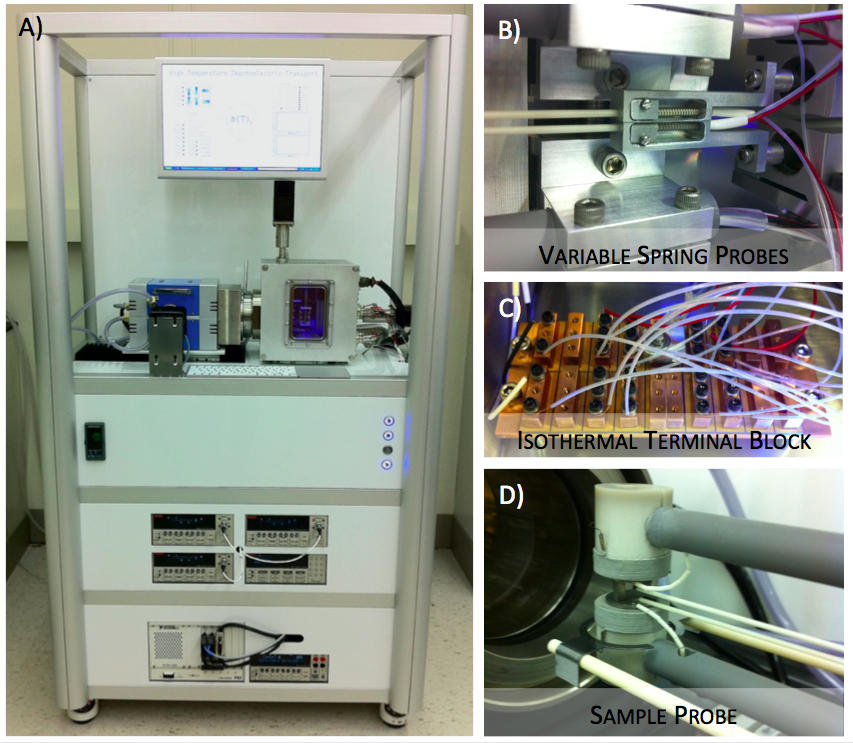Apparatus for the Measurement of High Temperature Thermoelectric Transport Properties

(a) Photograph of the instrumentation enclosure for the high temperature thermoelectric apparatus. (b) Photograph of the 4-probe thermocouple spring mounts. (c) Photograph of the isothermal terminal block and reference junction. (d) Photograph of the sample probe showing the 2-probe and 4-probe thermocouples and the bifilar sample heaters.
Description
The Seebeck coefficient is a widely measured transport property that provides fundamental information on charge carrier transport and the electronic structure of materials, as it can be related to the reduced Fermi level, band gap, carrier concentration, effective mass, and carrier scattering mechanisms. More specifically, the Seebeck coefficient is an important predictor of thermoelectric material performance; it is the proportionality constant that quantifies the energy conversion of an applied temperature difference into an electric potential. Materials that exhibit a large Seebeck coefficient, in addition to high electrical conductivity and low thermal conductivity, are considered candidates for use in thermoelectric applications.
However, researchers employ a variety of techniques, conditions, and probe arrangements to measure the Seebeck coefficient, resulting in conflicting materials data. To identify optimal measurement practices and protocols, we have designed and constructed an experimentally flexible high temperature thermoelectric measurement apparatus uniquely capable of in situ comparison of different contact geometries and measurement techniques that are commonly employed in both commercially available and custom developed instrumentation. Our instrumentation measures the Seebeck coefficient (2-probe and 4-probe) in combination with electrical resistivity (4-probe) between 300 K and 1200 K. This apparatus was also designed to realize the accuracy requirements for SRM development and certification.
Instrumentation details, including those pertaining to the listed Specifications/Capabilities and construction guides, can be found in the reference: J. Martin, “Apparatus for the High Temperature Measurements of the Seebeck Coefficient in Thermoelectric Materials,” Review of Scientific Instruments, 83, 065101 (2012).
Using this custom instrumentation, we have completed a comprehensive experimental study establishing recommended measurement practices and protocols, enabling the development of a thermal contact error model to guide researchers in designing improved instrumentation and in developing comprehensive uncertainty limits. These recommendations can be found in the reference: J. Martin, Protocols for the High Temperature Measurement of the Seebeck Coefficient in Thermoelectric Materials, Meas. Sci. and Technol. 24, 085601 (2013).
Please contact Joshua Martin for additional information or for further questions.
Specifications/Capabilities
- Measures electrical resistivity and Seebeck coefficient from 300 K to 1200 K
- Uniquely capable of in situ comparison of various characterization methodologies and probe arrangements
- Three synchronized nanovoltmeters are used to eliminate correspondence distortion in the measured Seebeck coefficient
- Sample thermocouple probes automatically adjust distance for optimal resistivity measurements
- Improved design for isothermal reference/connection junctions using dual gold plated aluminum nitride, oxygen-free copper triple terminal blocks, and platinum resistance thermometers for high accuracy reference junction temperature measurements
- Custom Cu-to-Cu vacuum thermocouple feedthroughs to eliminate errors from traditional extension wires
- The aluminum nitride/tungsten probes accommodate parallelepipeds and disks, in both transverse and longitudinal orientation
- Uses dual, bifilar wound (noninductive) sample heaters to verify thermal contacts and to allow multiple quadrant Seebeck measurements
Scientific Opportunities/Applications
This instrument allows us to provide the underpinning measurement science needed to support the development, production and reliability of materials and devices related to thermoelectric energy-harvesting applications. In addition, electrical resistivity and Seebeck coefficient property data at high temperature are critical to understand structure-property relationships in a variety of applications.

